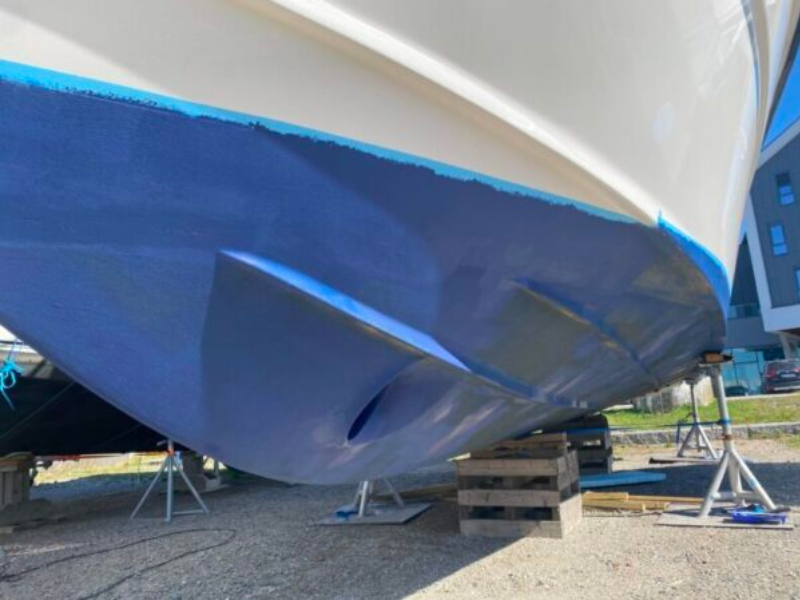The science behind antifouling paint: protect your boat all year round

To ensure optimal performance and a long life of your boat, it is essential to keep it in excellent condition. One of the crucial aspects of this maintenance is the application of antifouling paint. In this article, we discuss the science behind antifouling paint and how it can protect and enhance your boat. In addition, we will offer you advice on when and how to repair your boat in a shipyard.
What is antifouling paint?
Antifouling paint is a specialized paint coating that is applied to the hull surface of boats, both above and below the waterline. This paint plays a crucial role in the maintenance and protection of the boat, since its main function is to prevent aquatic organisms – such as algae, barnacles, molluscs and a variety of microorganisms – from adhering to the surface of the boat.
The accumulation of these organisms, a phenomenon known as fouling, can lead to a series of problems. First, fouling buildup can create hydrodynamic drag, which can slow your boat and increase your fuel consumption. Additionally, some of these organisms can be corrosive or damage the hull structure if allowed to grow unchecked.
The science behind antifouling Paint
Understanding the science behind antifouling paint means knowing how it works on a chemical and physical level to prevent the buildup of marine organisms on the hull of a boat. This paint is formulated with biocidal compounds, which are substances that can repel or kill fouling organisms.
In most antifouling paints, the biocide component is encapsulated within a resin matrix. When the paint is applied and exposed to water, the matrix slowly begins to dissolve, gradually releasing the biocide in a process known as controlled leaching. This constant release of biocide creates a hostile surface for marine organisms, deterring them from attaching to the hull or killing them if they try to do so.
The challenge with antifouling paint is balancing the release rate of the biocide. If the paint releases the biocide too quickly, the paint’s effectiveness will wear off sooner than expected, requiring premature recoating. If the paint releases the biocide too slowly, it will not provide effective protection against the buildup of organisms. That is why it is so important that this antifouling paint is applied by an expert like the ones we have at Barcelona Nautic Center
The latest innovations in antifouling paint science have led to the development of biocide-free paints, which use physical methods to deter fouling. These can include superhydrophobic surfaces that make it difficult for organisms to adhere, or nanotextured surfaces that mimic natural antifouling surfaces found in nature, such as shark skin.
How can antifouling paint protect and enhance your boat?
Antifouling paint offers a number of benefits for your boat or yacht. First, it provides effective fouling protection, which in turn prevents structural damage to your boat. By preventing the buildup of marine organisms, you can also maintain your boat’s optimum speed and performance, resulting in lower fuel consumption and higher overall efficiency year-round.
Plus, antifouling paint helps maintain a clean, attractive appearance, which never hurts. The buildup of marine organisms can disfigure and stain your boat’s hull, affecting its appearance and possibly its value if you want to sell your boat to buy a new or used one.
Boat maintenance in a shipyard
If your boat already shows signs of fouling or damage, it may be necessary to repair your boat in a shipyard. A shipyard is a facility designed to allow maintenance and repair of boats out of the water. Here, your boat can be safely lifted and supported while experts carry out the necessary repairs.
Repair and maintenance of your boat may involve removing old and damaged antifouling paint, repairing any structural damage, and applying a new coat of antifouling paint. This process can vary depending on the state and type of your boat, as well as the antifouling paint you choose.
–
To sum up, antifouling paint is an essential tool in the maintenance of your boat. It not only protects your boat from fouling and damage, but also improves its performance and appearance. When your boat needs to be repaired, trust a professional shipyard to ensure the job is done right.
Remember, safe and pleasant navigation is the result of careful and regular maintenance. Antifouling paint is a vital component of this maintenance. Understanding the science behind it and applying it correctly can make a big difference in the life and performance of your boat or yacht.




